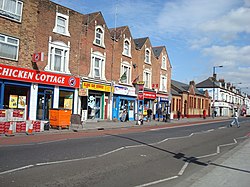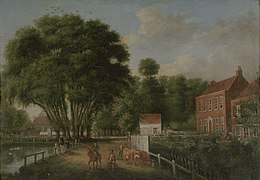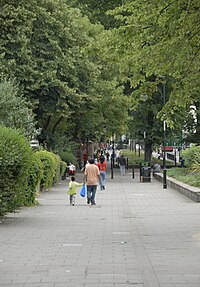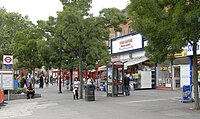Seven Sisters, Middlesex
| Seven Sisters | |
| Middlesex | |
|---|---|
 Seven Sisters Road | |
| Location | |
| Grid reference: | TQ334888 |
| Location: | 51°34’56"N, 0°4’25"W |
| Data | |
| Population: | 15,968 (2011) |
| Post town: | London |
| Postcode: | N15 |
| Dialling code: | 020 |
| Local Government | |
| Council: | Haringey |
| Parliamentary constituency: |
Tottenham |
Seven Sisters is an urban village which is effectively part of Tottenham, in the east of Middlesex. It is to be found at the eastern end of Seven Sisters Road, which runs from Tottenham High Road to join the A1 in Holloway.
Name
The Dorset map of 1619 shows the area known today as Seven Sisters named as 'Page Greene'. However, by 1805 the first series Ordnance Survey map was showing the area as 'Seven Sisters'.
The name is derived from seven elms which were planted in a circle with a walnut tree at their centre on an area of common land known as Page Green.[1] The clump was known as the Seven Sisters by 1732.[2]
In his early-seventeenth-century work, The Briefe Description of the Towne of Tottenham Highcrosse, local vicar and historian William Bedwell singled out the walnut tree for particular mention. He wrote of it as a local 'arboreal wonder' which 'flourished without growing bigger'. He described it as popularly associated with the burning of an unknown Protestant.[3] There is also speculation that the tree was ancient, possibly going back as far as Roman times, perhaps standing in a sacred grove or pagan place of worship.[4]
The location of the seven trees can be tracked through a series of maps from 1619 on. From 1619 they are shown in a position which today corresponds with the western tip of Page Green at the junction of Broad Lane and the High Road.
With urbanisation radically changing the area, the 'Seven Sisters' had been replanted by 1876, still on Page Green, but further to the east.[2] Contemporary maps show them remaining in this new location until 1955. The current ring of hornbeam trees was planted in 1997 in a ceremony led by five families of seven sisters.[4]
History
Seven Sisters is on the route of Ermine Street, the Roman road connecting London to York. At the time of the Domesday Book, the area was within the Manor of Tottenham held by Waltheof II, Earl of Northumbria, the last of the great Anglo-Saxon Earls.[5]
In the Middle Ages, a settlement grew up at Page Green and the woodland was increasingly cleared for agriculture. In the early decades of the nineteenth century, the Seven Sisters Road was constructed and the area saw the construction of a number of large houses, including Suffield Lodge, Seven Sisters House and Grove Place. These fine buildings soon fell victim to the spread of Victorian London and by the third quarter of the century the area had been almost completely built over.[2]
Seven Sisters today
Today Seven Sisters is a multi-cultural area strongly influenced by its location on key road and underground rail routes. Immediately above the tube station is an early-Edwardian department store building, formerly occupied by Wards Furnishing Stores, which traded until 1972. Part of the building, known locally as Wards Corner, is thriving as an indoor market with a strong Latin American flavour.[6]
The Clyde Circus Conservation Area stretches between the busy local shops of West Green Road and Philip Lane. Most of the residential streets between are in the Conservation Area, but not the more modern Lawrence Road and Elizabeth Place.
Society
Residents of the Clyde Circus Conservation Area are brought together by the Clyde Area Residents Association, which holds an annual street party. Its sister group, the Fountain Area Residents Association, covers residents to the south of West Green Road, namely those in Kirkton Road, Roslyn Road, Seaford Road, Elmar Road, Turner Avenue, Brunel Walk, Avenue Road and Braemar Road. Recent successful projects organised by FARA members include the creation of a community garden at the site of a dated pedestrian ramp.
Another recent community project is the Avenue Orchard: the local community utilised wasteland behind a concrete wall on Avenue Road for planting apple trees, and held a workshop with local artists to source ideas for how to improve the look and feel of the wall and area around the Avenue Orchard.
Outside links
| ("Wikimedia Commons" has material about Seven Sisters, Middlesex) |
References
- ↑ Just by the green was a tavern called the Seven Sisters.
- ↑ 2.0 2.1 2.2 A History of the County of Middlesex - Volume 5 pp @: Tottenham: Growth before 1850 (Victoria County History)
- ↑ W. Bedwell, Brief Description of Tottenham (1631), reprinted in W. J. Roe, Ancient Tottenham, 119}}
- ↑ 4.0 4.1 "Tree Trust for Haringey". http://www.ttfh.org.uk/newsflas.htm. Retrieved 20 April 2018.
- ↑ A History of the County of Middlesex - Volume 5 pp 324-330: Hendon, Kingsbury, Great Stanmore, Little Stanmore, Edmonton Enfield, Monken Hadley, South Mimms, Tottenham (Victoria County History)
- ↑ Pueblito Paisa


